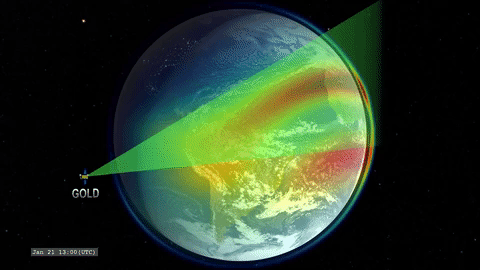By Miles Hatfield
NASA’s Goddard Space Flight Center
New results from NASA satellite data show that space weather – the changing conditions in space driven by the Sun – can heat up Earth’s hottest and highest atmospheric layer.
The findings, published in July in Geophysical Research Letters, used data from NASA’s Global Observations of the Limb and Disk, or GOLD mission. Launched in 2018 aboard the SES-14 communications satellite, GOLD looks down on Earth’s upper atmosphere from what’s known as geosynchronous orbit, effectively “hovering” over the western hemisphere as Earth turns. GOLD’s unique position gives it a stable view of one entire face of the globe – called the disk – where it scans the temperature of Earth’s upper atmosphere every 30 minutes.

“We found results that were not previously possible because of the kind of data that we get from GOLD,” said Fazlul Laskar, who led the research. Dr. Laskar is a research associate at the Laboratory for Atmospheric and Space Physics at the University of Colorado, Boulder.
From its perch some 22,000 miles (35,400 kilometers) above us, GOLD looks down on the thermosphere, a region of Earth’s atmosphere between about 53 and 373 miles (85 and 600 kilometers) high. The thermosphere is home to the aurora, the International Space Station, and the highest temperatures in Earth’s atmosphere, up to 2,700 °F (1,500 °C). It reaches such incredible temperatures by absorbing the Sun’s high-energy X-rays and extreme ultraviolet rays, heating the thermosphere and stopping these types of light from making it to the ground.

But the new findings point to some heating not driven by sunlight, but instead by the solar wind – the particles and magnetic fields continuously escaping the Sun.

The solar wind is always blowing, but stronger gusts can disturb Earth’s magnetic field, inducing so-called geomagnetic activity. Laskar and his collaborators compared days with more geomagnetic activity to days with less, and found an increase of over 160 °F (90 °C) in thermospheric temperatures. Magnetic disturbances, driven by the Sun, were heating up Earth’s hottest atmospheric layer.
Some amount of heating was expected near Earth’s poles, where a weak point in our magnetic field allows some solar wind to pour into our upper atmosphere. But GOLD’s data showed temperature increases across the whole globe – even near the equator, far from any incoming solar wind.
Laskar and colleagues suggest it has to do with changing circulation patterns. There’s a swirling of air high above us — a global circulation that pushes air from the equator up to the poles and back around at lower altitudes. As the solar wind pours into the thermosphere near the poles, the added energy can alter this circulation pattern, driving winds and atmospheric compression that can raise temperatures even far away.
Changing circulation might also underlie another surprise finding. GOLD’s data showed the amount of heat added depended on the time of day. The team discovered a stronger effect in the morning hours compared to that in the afternoon. They suspect that geomagnetic activity might especially strengthen the circulation during the night and early morning hours, though this explanation awaits confirmation in further studies.
Laskar was most impressed with the subtlety of the changes they could detect in GOLD’s data.
“We used to believe that only prominent geomagnetic events could change the thermosphere,” Laskar said. “We are now seeing that even minor activity can have an impact.”
With its steady stream of temperature measurements, GOLD is painting a picture of an upper atmosphere much more sensitive to the magnetic conditions around Earth than previously thought.

